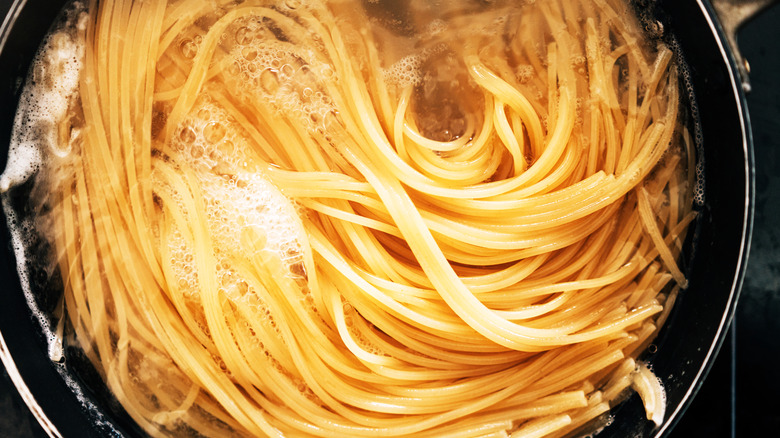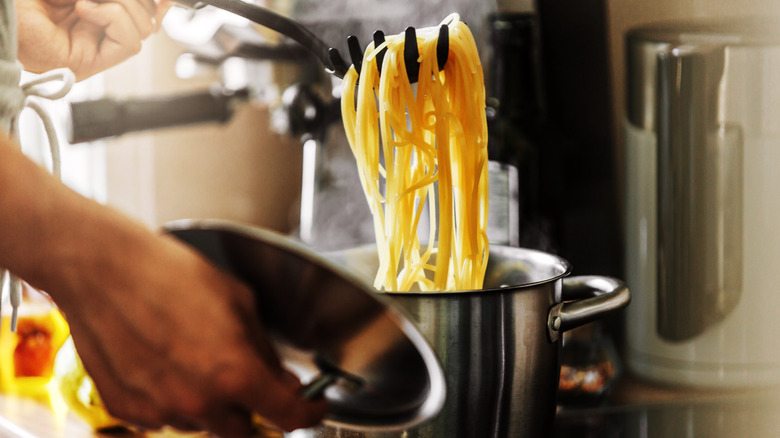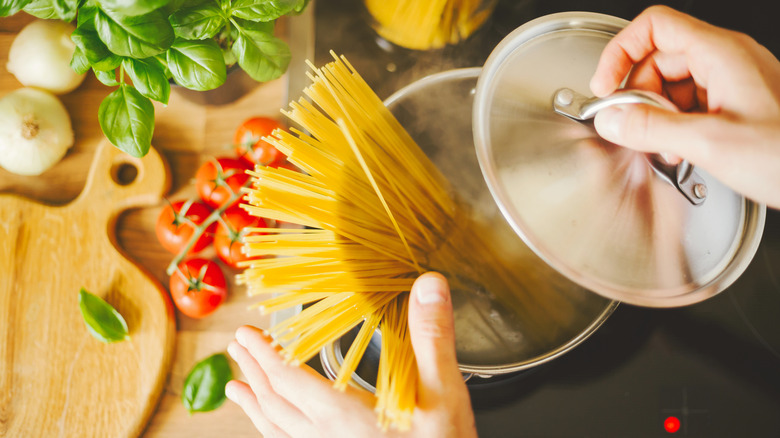Here's How Boiling Too Much Water Could Be Affecting Your Pasta
It's no secret that the proper way to cook pasta can be a hot-button issue, inspiring carb-fueled debates and incensing Italian nonnas everywhere. In fact, there are entire Twitter accounts and online communities dedicated to documenting the passion with which many approach the cuisine.
Due to this age-old debate, there is endless (and sometimes conflicting) information on cooking a pot of pasta perfectly. From helpful tips on how to season the water to myths about pasta, every cook has their own beliefs on what to do or not to do when it comes to mastering noodles. But, there's one key element of pasta-making that's often overlooked in the heated discourse: the quantity of water needed to boil pasta.
No matter if you're a fan of creamy pancetta-laced carbonara, silky penne alla vodka, or a simple spaghetti that lets the ingredients shine, we discovered the perfect hack that benefits any pasta dish and takes your boiling game to a whole new level.
Reducing the amount of water can make for the best pasta ever
While most carb-loving home cooks know that adding some of the starchy pasta water to the pan is crucial to a rich, authentic sauce, many don't pay enough attention to the initial water quantity. According to The Daily Meal, reducing the quantity of water used to cook a pot of pasta can lead to a more delicious dish overall.
The reason for this comes down to the starches, which release into the boiling water as the pasta cooks and provide the thickening agent necessary to bring the sauce and pasta together in one perfectly married dish. When the water initially used to boil the pasta is reduced, this results in more concentrated pasta water containing a higher quantity of starch. The emulsification process of the sauce is even more effective with less water, creating a silkier sauce and a more mouth-watering dining experience.
Reducing your water quantities while boiling pasta can also save on electricity or gas and even benefit the environment. According to The New York Times, if every American reduced their pasta water quantities for a year, it could save on several trillion B.T.U.s of stovetop energy — equivalent to roughly 250,000 to 500,000 barrels of oil at a power plant.
What's the ideal quantity of water to cook pasta in?
Although reducing water quantity can result in a more delicious dish, not adding enough water to your pot can also lead to an unsatisfactory plate of pasta. The standard pasta to water ratio — five to eight quarts of well-salted water per pound of pasta — was established by Maria Lo Pinto in the classic 1948 cookbook, "The Art of Italian Cooking." While this rule of thumb is largely still followed today, the water quantity should fluctuate depending on what type of pasta you're preparing.
According to The Daily Meal, longer pasta, like spaghetti and linguini, will require more water to cook than shorter kinds of pasta like penne and farfalle. Pasta should be fully submerged with one to two inches of water above it. Not providing enough pasta water initially can result in undercooked pasta that sticks to the pan.
There's a fine line between how much and how little pasta water to use. But the average home cook can benefit from reducing the water used to cook their pasta, if for nothing else but to reach a new level of starchy, silky deliciousness in every saucy dish they create. Feeling inspired or just downright hungry? Try out this boiling hack, and check out these quick pasta recipes you can whip up for dinner on even the busiest of nights.


